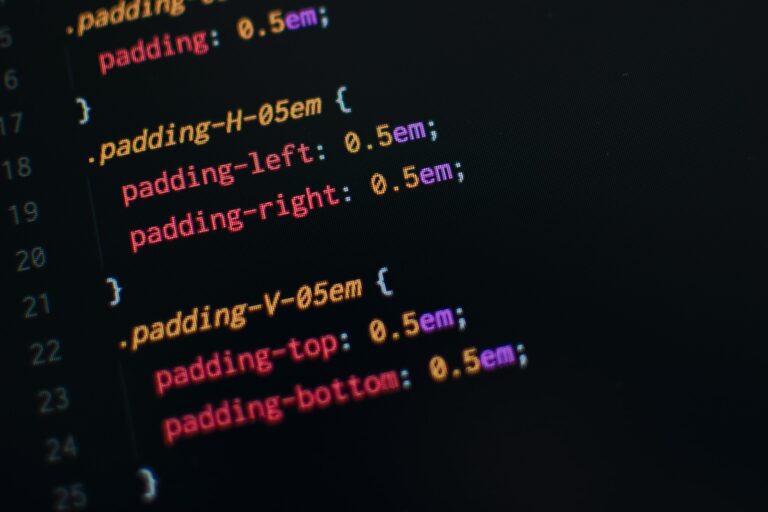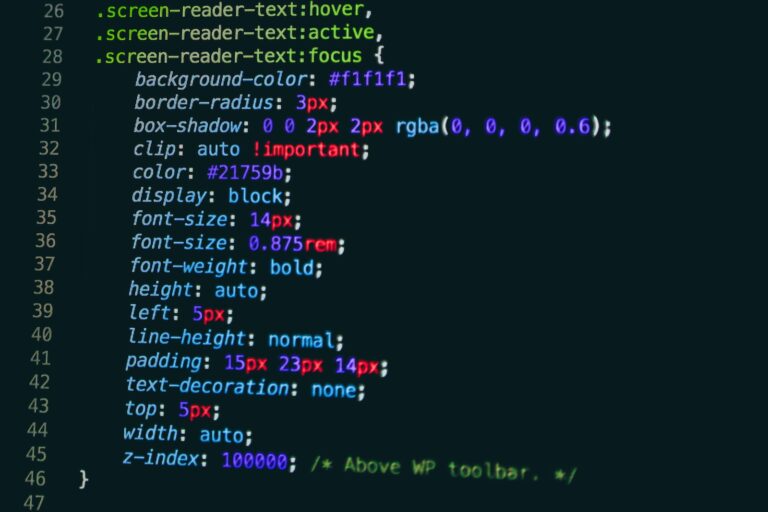As a web developer, you know that CSS is a critical component of any website. But did you know that the way you write CSS code can significantly impact your website’s loading times and user experience? CSS performance optimization is crucial for ensuring that your website loads quickly and smoothly, improving visitor retention rates and overall website success. In this article, we will explore techniques and best practices for writing efficient CSS code that can help you optimize your website’s performance and ensure that it loads lightning-fast on any device.
Key Takeaways:
- CSS performance is vital for a website’s success and user experience.
- Writing efficient CSS code can help optimize website performance.
- There are several techniques and best practices for improving CSS performance, including minimizing and concatenating CSS files, reducing CSS code size, simplifying CSS selectors, leveraging CSS preprocessors, and using framework and libraries.
- Optimizing media queries and responsive design, as well as CSS animations, can also improve performance.
Understanding CSS Performance
CSS performance is a critical factor that affects the loading speed of your website. Slow-loading websites can lead to a poor user experience, resulting in lost traffic and revenue. CSS performance refers to the efficiency and speed of your CSS code and how it affects the rendering of web pages.
Several factors can impact CSS performance, including the size and complexity of your CSS code, the number of CSS files, and how you structure your selectors. Understanding these factors is crucial to creating efficient and optimal CSS code that enhances website performance.
Minimizing and Concatenating CSS Files
One effective way to improve CSS performance and optimize website loading times is by minimizing and concatenating CSS files. By minimizing the number of CSS files, you can reduce the number of HTTP requests and improve page load times. By concatenating CSS files into a single file, you can also reduce the file size and improve loading speed.
Here are some techniques and tools you can use to minimize and concatenate CSS files:
| Technique/Tool | Description |
|---|---|
| Code minification | Removes unnecessary whitespace, comments, and other characters to reduce file size. |
| Concatenation | Combines multiple CSS files into a single file to reduce HTTP requests and improve loading speed. |
| CSS preprocessors | Allows you to write your CSS code in multiple files and then compile them into a single, optimized file for production. |
| CSS frameworks | Provides a pre-built CSS structure that can help reduce the amount of custom code needed and improve performance. |
When implementing these techniques, it’s important to ensure that your CSS code remains readable and maintainable. Using tools like CSS Lint or CSSNano can help you optimize your CSS code while still keeping it organized and easy to understand.
Reducing CSS Code Size
Large CSS files can significantly impact website loading times and overall performance. By reducing the size of your CSS code, you can improve website performance without sacrificing design or functionality.
Here are some techniques to optimize your CSS code:
1. Remove Redundant CSS
Review your CSS code and remove any redundant styles or selectors. This can include styles that aren’t being used on any elements, or selectors that are being overwritten by other styles.
2. Use Shorter Selectors
Using shorter, more specific selectors can help reduce the size of your CSS code. Instead of writing multiple selectors to target a single element, use a single, more specific selector.
| Example: | Instead of writing:nav ul li a {}Write: .nav-link {} |
|---|
3. Use Shorthand Properties
Using shorthand properties can help reduce the size of your CSS code and make it easier to read and maintain. Instead of writing out individual properties for a given element, use the shorthand property.
| Example: | Instead of writing:padding-top: 10px;Write: padding: 10px 20px; |
|---|
4. Use CSS Preprocessors
CSS preprocessors like Sass and Less offer features that can help you write more concise and efficient CSS code. For example, variables, mixins, and functions can help reduce the amount of code you need to write for repeating styles.
5. Minify Your CSS
Minifying your CSS code involves removing all unnecessary characters, including spaces and comments. This can significantly reduce the size of your CSS file and improve website performance.
| Example: | Original CSS:/* This is a comment */Minified CSS: body{font-family:Arial,sans-serif;background-color:#f2f2f2;} |
|---|
By implementing these techniques, you can significantly reduce the size of your CSS code and improve website performance. Remember, optimizing your CSS code is an ongoing process that requires periodic reviews and updates to ensure optimal performance.
Simplifying CSS Selectors
Simplifying CSS selectors plays an important role in optimizing your website’s performance. Complex selectors can slow down your website, making it harder for users to access the information they need.
Importance of Simplifying Selectors
Simplifying selectors can significantly improve CSS performance. This is because complex selectors require more processing power from the browser, resulting in slower loading times. Additionally, complex selectors can also make it harder for developers to maintain and update code, leading to longer development times and potential errors.
To simplify selectors, it is important to use classes and IDs instead of complex selectors. Classes and IDs are easier to read, understand, and maintain, and they also require less processing power from the browser.
Tips for Optimizing Selectors
There are several tips for optimizing your selectors to improve performance. First, limit the number of selectors used per rule. This can help reduce the complexity of your CSS code and improve loading times. Additionally, try to avoid using universal selectors, as they can be slow and inefficient.
Another tip is to avoid chaining selectors together. Instead, use classes and IDs to target specific elements. This will make your code easier to read and understand, and will also improve loading times.
Lastly, consider using preprocessors like Sass or Less to optimize your selectors. These tools can help simplify your code and improve performance by reducing the amount of CSS that needs to be processed by the browser.
Efficient Use of CSS Preprocessors
If you’re looking to optimize your CSS code for better performance, CSS preprocessors like Sass and Less can be incredibly helpful tools. They offer a range of features that can help you write more efficient code and organize your stylesheets more effectively, ultimately leading to better CSS performance. Here are some tips for leveraging CSS preprocessors to enhance your website’s performance:
- Take advantage of variables: One of the biggest advantages of using a CSS preprocessor is the ability to define and use variables. By defining variables for commonly used values like colors, font sizes, and spacing, you can streamline your CSS code and make it easier to update consistently across your website.
- Use nesting to your advantage: CSS preprocessors allow you to nest selectors, which can help make your code more readable and easier to organize. However, be careful not to nest too deeply as it can lead to overly specific and complicated selectors which can impact performance.
- Minimize redundancy: By utilizing mixins and functions, you can avoid repeating code throughout your stylesheet. This not only reduces redundancy but can also make it easier to update styles across your website. Just like with nesting, be careful not to overuse mixins and functions as they can potentially slow down your website if used excessively.
By implementing these tips when using a CSS preprocessor, you can optimize your CSS code and boost your website’s overall performance.
Leveraging CSS Frameworks and Libraries
CSS frameworks and libraries can provide a great starting point for designing and styling websites. However, it is important to use them effectively to ensure they don’t negatively impact performance. Here are some best practices to follow when using CSS frameworks and libraries:
1. Choose a Lightweight Framework
When selecting a CSS framework, choose a lightweight option that includes only the necessary features. This will reduce the amount of CSS code that needs to be loaded, improving website performance. Examples of lightweight frameworks include Skeleton and Pure CSS.
2. Use Only What You Need
Don’t include unnecessary components or styles from the framework or library. This can lead to bloated CSS code and negatively impact performance. Instead, only use what is needed for the specific project to keep the CSS code lean and efficient.
3. Customization
Consider customizing the framework or library to match the specific design and functionality of the website. This can reduce the amount of CSS code needed and improve performance. However, be cautious as excessive customization can lead to complex code, which can negatively impact performance.
4. Minimize HTTP Requests
To further optimize performance, consider using a single CSS file that includes all the necessary code from the framework or library. This will minimize the number of HTTP requests and improve website performance.
By following these best practices, you can effectively leverage CSS frameworks and libraries to enhance website design and performance.
Media Queries and Responsive Design
Media queries and responsive design are crucial elements of modern web design. By using media queries, websites can adapt to different device sizes and create a seamless user experience. However, poorly optimized media queries can negatively impact CSS performance, leading to slow loading times and user frustration. In this section, we will explore best practices for optimizing media queries and responsive design to enhance CSS performance.
Optimize Media Query Structure
One of the best ways to optimize media queries is to ensure they are structured efficiently. By following a mobile-first approach and only including styles relevant to each breakpoint, you can reduce the number of styles loaded and improve overall performance. Avoid using long lists of styles or repeating styles across media queries. It is also important to keep media queries as close to the relevant stylesheet as possible, rather than placing them in a separate file.
Use Appropriate Breakpoints
Choosing the right breakpoints for your website is crucial in ensuring a responsive design and optimal performance. Consider the screen sizes of your users and design for the most common resolutions. Avoid creating too many breakpoints, as this can lead to a cluttered stylesheet and slower loading times. It is also important to test your website on different devices to ensure a consistent user experience.
Implement Lazy Loading for Images
Images are often the biggest culprit for slow loading times on mobile devices. By implementing lazy loading for images, you can improve performance by only loading images when they are needed. This can be achieved through JavaScript or the use of plugins. Be sure to compress images to reduce file size and avoid using large images that are not necessary for the design.
Avoid Using Inline Styles
Inline styles can impact CSS performance by adding unnecessary bloat to the stylesheet. Instead, use external stylesheets for your media queries and avoid using inline styles whenever possible. This will ensure that your website loads faster and is easier to maintain in the long run.
Conclusion
Optimizing media queries and responsive design is essential in creating a fast and responsive website. By following best practices and implementing efficient techniques, you can improve CSS performance and create a seamless user experience across all devices.
CSS Animation Performance Best Practices
CSS animations can enhance the user experience on your website, but they can also negatively impact performance if not optimized properly. Here are some best practices for optimizing CSS animations:
- Use keyframe animations instead of transitions: Keyframe animations are more efficient than transitions for complex animations, as they allow for more control over the animation timing and easing. Transitions are best used for simple animations.
- Avoid animating properties that trigger layout: Animating properties such as width and height can trigger layout changes, which can significantly impact performance. Instead, try to animate properties such as opacity or transform.
- Optimize animation timing: Timing is crucial for creating smooth animations. Use shorter animation durations and avoid unnecessary delays or pauses.
- Limit the number of animated elements: Animating too many elements at once can cause performance issues. Try to limit the number of elements being animated and consider animating only the most important elements.
- Consider using JavaScript for complex animations: For more complex animations, using JavaScript can be more efficient than using CSS. This allows for more control over the animation and can lead to better performance.
Note: Always test your animations on different devices and browsers to ensure they perform well and appear as intended.
Browser Compatibility and CSS Performance
Different web browsers handle CSS code differently, which can affect the performance of your website. Therefore, it is essential to ensure browser compatibility when optimizing your CSS code for optimal performance.
To enhance compatibility, use standardized CSS properties and avoid vendor-specific extensions. Also, test your website on different browsers and devices to identify and fix any compatibility issues.
In addition, consider using CSS resets, which can help eliminate inconsistencies in browser rendering and improve the consistency and predictability of your website’s appearance.
Overall, prioritizing browser compatibility is crucial for improving your website’s CSS performance and creating a seamless user experience across different devices and platforms.
Conclusion
In conclusion, writing efficient CSS code is essential for optimizing website performance and creating a better user experience. By applying the techniques and tips covered in this article, you can significantly improve CSS performance and reduce loading times.
It is important to understand the factors that impact CSS performance and take necessary steps to minimize CSS file sizes, simplify selectors, and optimize media queries and responsive design. Using CSS preprocessors and libraries can also provide an effective way to improve performance.
Additionally, it is crucial to ensure browser compatibility and carefully optimize CSS animations to avoid performance issues.
Incorporating these best practices for CSS performance optimization will not only improve website speed and overall performance, but also enhance user engagement and satisfaction. Take the time to analyze and fine-tune your CSS code for optimal results.







